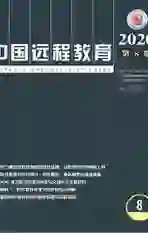英文摘要
2020-09-03
Regional credit banks for lifelong learning: functions, service models and implementation strategies
Nanzhong Wu, Haiying Xia and Bocheng Jiang
With rapid socioeconomic transformation and upgrading, lifelong learning has gradually become a routine part of life for many people. Thus, the certification, accumulation and transformation of lifelong learning achievements requires strong support from credit banks. This paper, drawing from research studies, development and working experience of credit bank teams, constructs a service model for regional credit banks of lifelong learning, and implementation strategies. The basic functions of such credit banks include certification, accumulation and transformation of various learning results, extending to the communication and connection among different educational institutions, resource sharing, flexible learning, self-adapted learning and reform in learning and teaching. The credit bank systems can and should be constructed and implemented successfully only when the government takes the full responsibility in the form of social governance, with expertise input for the overall design, general framework, dynamic mechanism and multiple technical support platforms. This study provides a theoretical reference for the construction of credits banks of regional lifelong learning.
Keywords: credit bank; lifelong learning; overpass; qualification framework; function; service model; implementation strategies
The relationship between the knowledge flow characteristics and the interaction level of cMOOC learners
Hao Tian, Li Chen, Luoying Huang and Ruixue Wang
“Internet + Education” presents a new concept of knowledge. As its ontological basis, connectivism holds that knowledge is constantly flowing, and knowledge flow is the purpose of learning. Knowledge flow can stimulate effective interaction, and deep interaction can also promote the formation of knowledge flow pipeline. This study, taking the first cMOOC in China - “Internet + Education: Dialogue between Theory and Practice II”, constructs the knowledge flow model from four aspects, i.e. breadth, intensity, speed and uniformity, and uses learners texts generated in the cMOOC platform as the data source. Social network analysis and keyword extraction technology are used to interpret the structure and content of knowledge flow on the level of interaction. The following conclusions are drawn in this study: (1) the breadth and intensity of knowledge flow are significantly positively correlated with the level of interaction; (2) there is no significant correlation between the speed of knowledge flow and the level of interaction; (3) centralized posting behavior is not conducive to achieving a good level of interaction; (4) the realization of way-finding interaction and sense-making interaction depends more on the structure of knowledge flow, while innovation interaction depends more on the content of knowledge flow. By quantifying the flow of knowledge, this study demonstrates the relationship between “pipeline” / “content in pipeline” and the interaction level of connectivism. In low-level interaction, “pipeline” is more important, while in high-level interaction, “content in pipeline” plays a more significant role. This conclusion provides an empirical basis for explaining the ontological value of connectivism.
Keywords: cMOOC; connectivism; knowledge flow; social network; interaction level; CIE framework; pipeline; content in pipeline
Designing blended learning in the Internet plus era
Xiaoying Feng, Jieting Cao and Luoying Huang
The practice of blended teaching and learning faces challenges and difficulties, requiring the guidance of methodological strategies. Defining teaching strategies at the macro level, the meso-level and the micro level, and focusing on the meso-level ones, this paper puts forward four evaluation criteria for blended learning design: effectiveness, efficiency, attraction and personalization. Using the research instruments of qualitative case analysis, content analysis and coding analysis, in the 82 typical domestic and international blended teaching cases, the authors identify four typical strategies to meet the evaluation criteria, namely clarity of core objectives, integration of online, offline and on-site teaching, open learning activities and authentic learning experiences, and data-driven learning analytics. Finally, the four strategies are verified in one typical case against the evaluation criteria. It is hoped that this study will provide some practice-based reference for blended teaching practitioners and researchers.
Keywords: blended teaching; blended learning; blended teaching design; learning design; empirical case; the Internet plus education; methodology; strategy
A contextualization - generalization - recontextualization cycle in open and distance education theory building and application: a cultural perspective
Insung Jung
While a theory in open and distance education or ODE aims to understand knowledge and guide research and practice regardless of cultural and contextual differences, it cannot be totally free from those cultural and contextual influences. Based on the understanding of cultural and contextual differences found in teaching and learning, technology adoption and ODE, this paper proposes a contextualization - generalization - recontextualization cycle in the ODE theory building and application. This cycle begins with a contextualized theory building in which the theory helps to formulate meaningful research questions, collect appropriate data and analyze them properly, and interpret them in a specific context. The theory is then applied to research and practice in various contexts and becomes generalizable across different ODE cases. To be more powerful as a theory, this generalized theory needs to be modified and elaborated for a particular cultural context based on empirical research adopting a cultural approach.
Keywords: contextualization-generalization-recontextualization cycle; cultural approach to research; open and distance education theory; technology adoption; traditional theories; theory building and application
(英文目次、摘要譯者:刘占荣)
